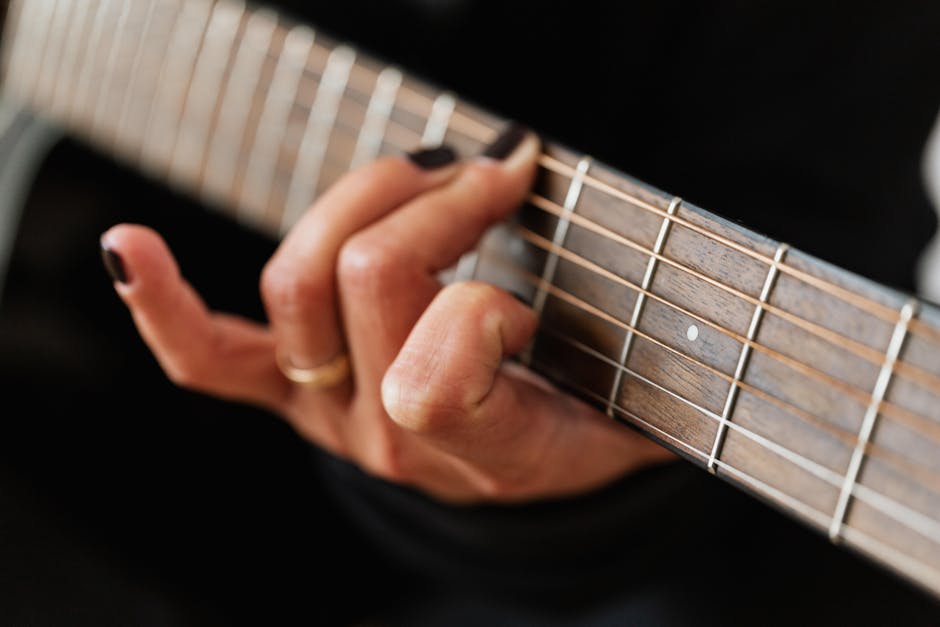So you’ve decided to take the plunge into the world of acoustic guitar, huh? Congratulations on choosing an instrument that’s sure to bring both joy and frustration in equal measures. But fear not, dear reader, for I am here to guide you through the labyrinth of chords, scales, and calloused fingertips that await you on this musical journey. So grab your guitar (and maybe a bandage or two), and let’s navigate the switch together with this beginner‘s guide to acoustic guitar.
Contents
- 1
- 2 Choosing the Right Acoustic Guitar for You
- 3 Mastering the Basic Chords and Strumming Patterns
- 4 Exploring Fingerpicking Techniques for Beginners
- 5 Developing Your Listening Skills and Ear Training
- 6 Incorporating Simple Songs into Your Practice Routine
- 7 Overcoming Common Challenges for New Guitarists
- 8 FAQs
- 9 Rock on, beginner guitarist!
anatomy-of-your-acoustic-guitar”>Understanding the Anatomy of Your Acoustic Guitar
So, you’ve decided to learn the ins and outs of your trusty ol’ acoustic guitar, huh? Well buckle up, because we’re about to dive into the fascinating world of guitar anatomy.
First things first, let’s talk about the body of your guitar. You know, the curvaceous shape that makes your heart skip a beat every time you strum a chord? That’s where all the magic happens. It’s usually made of wood (no surprises there) and comes in all shapes and sizes – from dreadnought to concert to jumbo. Each body type has its own unique sound, just like your favorite aunt’s quirky laugh.
Next up, we have the neck of the guitar. This is where your fingers work their magic to produce those sweet, sweet melodies. The neck is usually made of wood too, and is home to the fretboard – that long, smooth surface where you press down on the strings to play different notes. Ah, the sweet symphony of calloused fingertips and slightly out-of-tune sing-alongs.
And let’s not forget about the headstock, where the tuning pegs reside. These little guys are like the gatekeepers of your guitar’s sound. Keep them in tip-top shape, and your guitar will always be in tune. Neglect them, and you’ll be playing a sad, out-of-tune ballad in no time. Trust me, you don’t want that kind of embarrassment on your hands.
So there you have it, folks – a crash course in the anatomy of your acoustic guitar. Now go forth, and serenade the world with your newfound knowledge. Just remember to thank your guitar for putting up with all those missed notes and late-night jam sessions. Happy strumming!
Choosing the Right Acoustic Guitar for You
So you’ve decided to take the plunge and become a rockstar – or at least sound like one in your own living room. But with so many options out there, how do you choose the perfect acoustic guitar for you? Fear not, my aspiring musician friend, for I am here to guide you through the murky waters of guitar shopping.
First things first, consider your budget. No, you can’t just sell your kidney to afford that vintage Martin dreadnought. Look for a guitar that fits your budget without breaking the bank. Remember, it’s all about the music, not the mortgage.
Next, think about the sound you want. Do you want a bright and twangy sound, or something warmer and mellower? Different woods will produce different tones, so do some research and figure out what suits your style best. And don’t be afraid to try out a few guitars – it’s all part of the fun!
Finally, think about the size and shape of the guitar. Are you a tiny person who struggles to lift a regular-sized guitar? Look for a smaller body style. Are you a giant who makes Paul Bunyan look like a toddler? Go for a jumbo-sized guitar. Remember, the guitar should fit you like a glove – or at least like a comfy pair of jeans. Happy strumming!
Mastering the Basic Chords and Strumming Patterns
So, you’ve picked up a guitar and you’re ready to rock out like a pro, huh? Well, before you start shredding like Hendrix, you’re gonna need to master the basic chords and strumming patterns. But don’t worry, we’ve got your back!
First things first, let’s talk about those pesky chords. You’ve got your A, your D, your E – the gang’s all here. But don’t be fooled by their innocent names, these little guys can be tricky to wrangle. Just remember, practice makes perfect! And if all else fails, just pretend you meant to play that sour note.
Now, onto strumming patterns. This is where the magic happens, folks. Whether you’re going for a funky reggae groove or a hard-hitting rock anthem, the right strumming pattern can make all the difference. So, grab your pick (or your fingers, if you’re feeling fancy) and start experimenting. The power of the strum is in your hands!
So, there you have it – the keys to unlocking your inner guitar god. With some dedication, a touch of creativity, and maybe a little bit of air guitar practice in front of the mirror, you’ll be well on your way to . Now go forth, young shredder, and make some beautiful music!

Exploring Fingerpicking Techniques for Beginners
So you’ve decided to dive into the world of fingerpicking, huh? Well, get ready for a wild ride filled with calloused fingertips and strained wrist muscles! But fear not, brave beginner, for we are here to guide you through this magical journey of exploring fingerpicking techniques.
First things first, let’s talk about proper finger positioning. Make sure your fingers are arched over the strings like graceful ballerinas and keep those nails trimmed unless you’re going for that Eddie Van Halen look. Remember, it’s all about precision and control, not about accidentally shredding your guitar strings to bits.
Next up, let’s discuss the wonderful world of patterns. Start off with some simple patterns like the classic Travis picking or the ever-popular alternating bass technique. Experiment with different combinations and rhythms until you find a pattern that speaks to your soul. And don’t be afraid to get a little funky with it – fingerpicking is all about self-expression, after all!
And finally, don’t forget to practice, practice, practice! Rome wasn’t built in a day, and neither was your fingerpicking prowess. Set aside some dedicated time each day to hone your skills and watch as your fingers transform into magical music-making wizards. Before you know it, you’ll be fingerpicking like a seasoned pro and serenading audiences with your dulcet tones. So grab that guitar, unleash your inner fingerpicking beast, and let the music flow!
Developing Your Listening Skills and Ear Training
So, you fancy yourself a musician, eh? Well, let me tell you, having good listening skills and ear training is like having a secret superpower in the music world. Not everyone possesses this gift, which is why it’s essential to develop yours. Here are a few tips to help you sharpen those ears of yours:
First off, **practice, practice, practice**. Just like anything else in life, the more you do it, the better you’ll become. Spend time each day listening to different genres of music, focusing on different instruments, and trying to pick out specific parts of a song.
Next, **play music detective**. Listen to a song and try to break it down into its individual components. Can you distinguish the bassline from the melody? Can you identify the different instruments being played? This exercise will help train your ears to listen more attentively.
Another fun way to improve your listening skills is to **play musical games**. Try playing “Name That Tune” with a friend, where you have to guess the song within the first few seconds of hearing it. Or, challenge yourself to transcribe a song by ear. These games will not only make you a better listener but also make practicing more enjoyable.
Incorporating Simple Songs into Your Practice Routine
One way to spice up your practice routine is to incorporate simple songs into your repertoire. Don’t let the simplicity fool you; these songs can pack quite a punch when it comes to building your skills and keeping you motivated.
Here are a few reasons why adding simple songs to your practice routine can benefit you:
- They are a great way to warm up before diving into more challenging pieces.
- They help improve your sense of rhythm and timing.
- They are fun and can break up the monotony of practicing scales and technical exercises.
When choosing simple songs to incorporate into your practice routine, look for ones that are catchy and easy to play. Some popular choices include nursery rhymes, folk songs, and pop tunes.
- Focus on learning the melody first before adding in chords or harmonies.
- Practice playing the song at a slower tempo to ensure accuracy before speeding up.
- Don’t be afraid to experiment with different arrangements or styles to keep things interesting.
Overcoming Common Challenges for New Guitarists
Guitar playing can be a challenging but rewarding journey for beginners. Here are some common challenges for new guitarists and how to overcome them:
1. **Sore Fingers**: Your fingertips are probably going to hurt at first as you build up calluses. To help with the pain, you can try using over-the-counter pain relief creams or playing for shorter periods of time until your fingers toughen up.
2. **Frustration with Chords**: Learning chords can be tricky, especially when you’re just starting out. Take it one chord at a time and practice switching between them slowly. It’s better to play a chord cleanly than rush through and have it sound messy.
3. **Boredom with Practice**: Practicing can feel like a chore, but it’s essential for improving your skills. Mix things up by learning new songs, trying different genres, or even just jamming with other musicians. Keep it fun!
FAQs
Are calluses on my fingertips normal when learning to play acoustic guitar?
Yes, calluses are a badge of honor for any guitarist. Embrace the pain and keep strumming!
What is the best way to tune my acoustic guitar?
Tuning your guitar is like trying to find the perfect balance between chaos and harmony. Use an electronic tuner or, if you’re feeling adventurous, try tuning by ear – just be prepared for some interesting sounds along the way.
How often should I change my guitar strings?
Changing your guitar strings is like changing the oil in your car – it’s not always fun, but it’s necessary for optimal performance. Aim to change your strings every 1-3 months, depending on how much you play (or how sweaty your hands are).
What are some common beginner mistakes to avoid when learning to play acoustic guitar?
Ah, the pitfalls of the aspiring guitar player. Avoid pressing too hard on the strings (your fingers will thank you), neglecting proper finger placement, and expecting to sound like a rockstar overnight. Remember, even Jimi Hendrix had to start somewhere.
How can I stay motivated when learning to play acoustic guitar?
Stay motivated by setting small, achievable goals for yourself, practicing regularly (even if it’s just for a few minutes a day), and surrounding yourself with fellow guitar enthusiasts who can provide support and encouragement. And remember, the journey to guitar greatness is a marathon, not a sprint.
Rock on, beginner guitarist!
Congratulations on embarking on your acoustic guitar journey! Remember, music is not about perfection, it’s about enjoyment. So don’t worry if your fingers ache or if you hit a few wrong notes. Keep practicing, keep learning, and most importantly, keep strumming those strings like you’re the next guitar hero!
Now go forth, embrace the musical world that awaits you, and let your newfound skills serenade everyone around you. Who knows, you might just be the next acoustic sensation in town! So grab that guitar, unleash your inner rockstar, and most importantly, have fun making music. Keep on strumming, and may the chords be ever in your favor!



